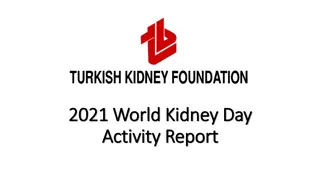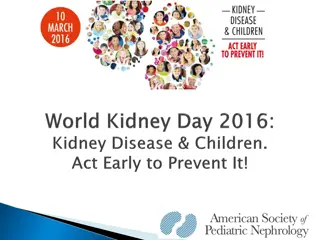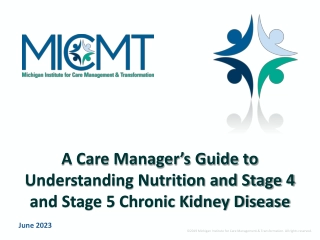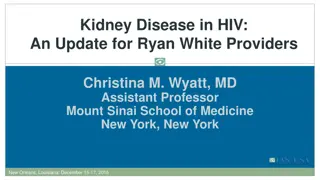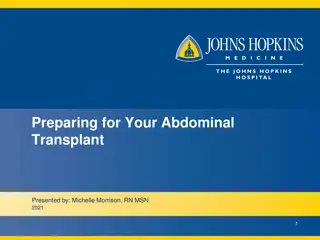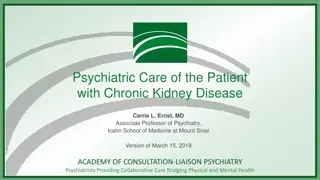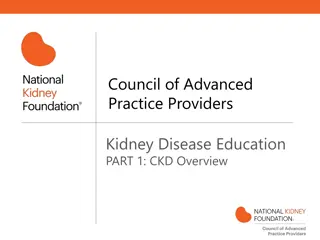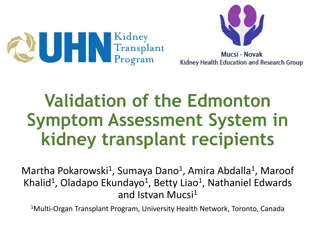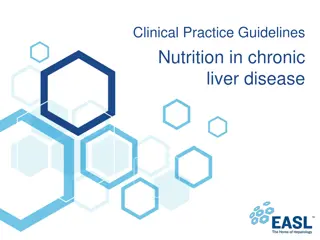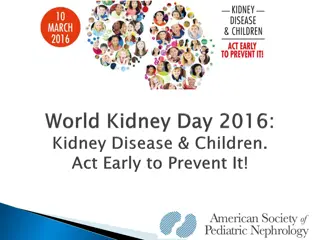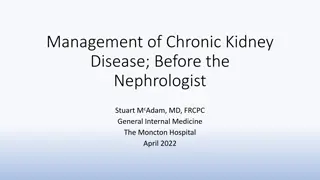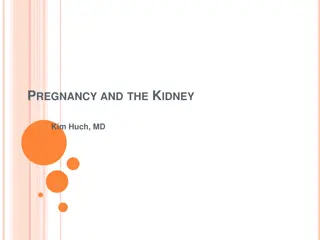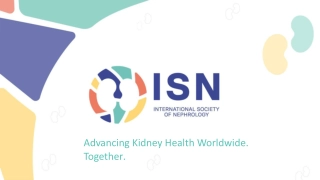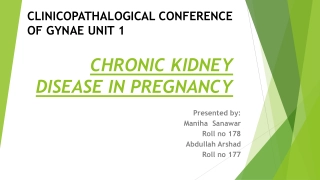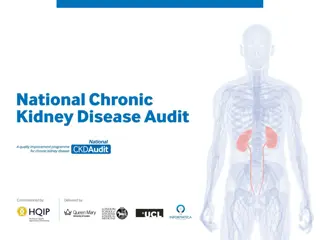Nutrition Strategies for Children with Chronic Kidney Disease
Strict attention to nutrition is crucial for optimizing growth and survival in children with chronic kidney disease. Poor growth can arise from various factors, including poor nutritional intake and other underlying health issues. Nutrient delivery routes and considerations for energy and protein intake play key roles in managing malnutrition and short stature in these patients.
Download Presentation

Please find below an Image/Link to download the presentation.
The content on the website is provided AS IS for your information and personal use only. It may not be sold, licensed, or shared on other websites without obtaining consent from the author. Download presentation by click this link. If you encounter any issues during the download, it is possible that the publisher has removed the file from their server.
E N D
Presentation Transcript
Shrouk Moataz Abdallah Teaching assistant of pediatrics, pedaitric clinical nutrition
Malnutrition/short stature in CKD Malnutrition/short stature in CKD Strict attention to nutrition is essential to optimise linear growth, wellbeing and survival. Without early nutritional intervention, losses of as much as 2 height standard deviations may occur in the first 6 months of life (critical phase). short stature and hypoalbuminemia at the start of dialysis is associated with a 2-fold increased mortality risk
Causes of poor growth Causes of poor growth A) Many factors, mainly POOR NUTRITIONAL INTAKE: 1-Anorexia due to: abnormal taste sensation, frequent oral medications, preference for water in polyuria 2-Nausea and vomitting 3-Abdominal fullness (PD) 4-GERD and delayed gastric emptying ( polypeptide H.) 5-Protein & Volume restrictions with delayed initiation of dialysis B) Others: protein loss in dialysis, acidosis, chronic inflammation, hormonal foctors..etc.
Routes of nutrient delivery Spontaneous oral intake Adequate intake/weight gain? Yes No Supplemental enteral feeding (continous night feeds +/- daytime bolus) NGT/gastrostomy (PEG) Open or closed system Intradialytic enteral nutrition (IDEN) BMI for-height-age? 5th centile Nephrotect parentral formula Intradialytic parentral nutrition (IDPN)
Closed system? Closed system?
Energy Energy 100% of the estimated average requirement for energy for chronological age. Inadequate energy from non-protein sources -use of dietary protein for energy not growth. -increase in plasma urea and potassium levels. Volume restriction: use nutrient dense foods (energy enhancers). Children on PD with glucose-containing dialysate may absorb up 10 12 extra kcal/kg/day
P Protein rotein Protein intake must provide at least 100% of the reference nutrient intake (RNI) to prevent growth failure. balance Protein excess Protein malnutrition Targets Albumin: normal Plasma urea: -less than 10 yrs 20 mmol/l -after 10 yrs 30 mmol/l
It is suggested to maintain dietary protein intake at : 100% to 140% of the DRI for ideal body weight in children with CKD stage 3 and at 100% to 120% of the DRI in children with CKD stages 4 to 5. (C) 100% of the DRI for ideal body weight plus an allowance for dialytic protein and amino acid losses in children with CKD stage 5D. (C)
Protein and energy requirements Protein and energy requirements
Energy and protein exchange of common foods Energy and protein exchange of common foods ) ( ) ( 60 3 60 3 3 80 3 10 60 7 3 50 1 1 80 7 1 80 9 ) 50 ( 50 6 ) 50 ( 120 10.5 ) 50 ( 20 0.75 5 1 22 0.9 5 1 20 0.35 5 1 67 3.5 ) 100 ( 70 4 ) 120 ( % 1
Inadequate oral and/or enteral protein intake should be considered when children with CKD stages 2 to 5 are unable to meet their protein requirements through food with tight volume restriction use protein supplements to augment 1 scoop (5g) 4.5 g aminoacids
Ketoacid supplements with low protein diet!! Ketoacid supplements with low protein diet!! Compound -Ketoacid Tablets Combine with ammonia to form essential aminoacids: 1. symptoms of uremia. 2. Protect the remaining renal functions 3. Guarantee the patients nutrition even with reduced protein intake. 4. Improve the metabolic complications of ureamia.
Ketosteril tablets: Indications & dosage Ketosteril tablets: Indications & dosage CKD with GFR less than 25ml/min. Dosage: children aged 3 and older: 1 tab. / 5 kg BW / day or 100 mg / kg / day. 3 times / day with meals. The tablets should be swallowed, without chewing.
Tips in protein and Energy calculations Tips in protein and Energy calculations Euvolemic (DRY) weight should be used: -HD average weight after hemodilaysis sessions -PD weight minus dialysis fluid in the peritoneal cavity Avoid underestimation in stunted patients: use height age (the age at which the child's height would be on the 50th percentile). Avoid overestimation in obese: use adjusted weight = ideal weight for height + 25% [actual weight ideal weight].
Example: 2y 6 mo old male, on PD, BW= 10kg, length=82cm Length 5th centile (stunted) Length age = 18 months 1.4 10 = 14 g/day. Proteins (length age)= Calories (length age)= 125 10 = 1250 kcal/day
Daily Daily 14 14 g protein exchange g protein exchange ) ( 1 1 ) 3.5 ) ( 2.5 ) ( 2 ( 3 ( . 1 2 6 ) ) ( 2 Protein calories: 350 kcal Remaining non-protein calories= 1250-350= 900 kcal
Adequate non-protein calories through nutrient dense foods and low protein alternatives = maximium efficacy of protein utilization
Rest of calories: non Rest of calories: non- -protein sources protein sources . - - ( ) . . . - - - - - . . Energy enhancers or fortifiers-
Fortification of food Fortification of food 1- Duocal powder: Protein free - Electrolytes free Balanced blend of carbohydrates and fats Included scoop= 1g powder= 5 kcal Dilutuion: gradually added to baby s formula or enteral feeds (1 g scoop every day) till maximium of 7 scoops/ 100ml less than 6 months 10 scoops/ 100ml 6-12 months In older children can be mixed with food up to 1:3 dilution with keeping osmolarity of 310mosm
2-Other energy enhancers At age of weaning (4-6 month) and older we can replace it with a mixture of carbohydrates and fats for natural sources: Carbohydrate sources: -Cornstarch (1 tbsp= 10g= 35 kcal) -Honey (1 tbsp = 60 kcal) Fat sources: -Olive oil or any vegetable oil (1 tbsp= 15ml= 135 kcal)
Fluids: Tips in restricting oral fluid intake Fluids: Tips in restricting oral fluid intake In orally fed: -Reduce the intake of beverages, foods that are liquid or semiliquid at room temperature (eg, ice, soup, Jell-O, ice cream, yogurt, pudding, and gravy). -Drinking only when thirsty, taking small amounts throughout the day using small cups or glasses. -Sucking on crushed ice, eating cold fruit, chewing gum and avoiding high- sodium or very sweet foods. Formula or nasogastric tude feedings: The free water content of infant formulas (~90% by volume) and enteral feedings (70% to 85%) should be considered when formulating feeding regimens.
Sodium Sodium In case of oliguria restrict Na 1-2 mmol/kg/day (1 mmol= 23mg) -Na content of Breast milk (0.8mmol/100ml) and standard infant formulas (1-1.5mmol/100ml) are apropriate till 150ml/kg/day -no added salt during food preparation -low Na food alternatives (fresh food, avoid canned& proccessed) -Consider Alkali therapy as part of the daily sodium allowance. In case of peritoneal dialysis 2-5 mmol/kg/day In case of polyuria more liberal use of Na up to supplementing Na if required (1/4 teaspoon of table salt = 17 mmol).
One teaspooon of salt = 2300 mg Nacl Sodium intake 5-10% table salt added to food 10% naturally occuring in food NO added salt Replace with fresh herbs & spices 75% added during food Processing & canning Choose low Na alternatives Replace with fresh food
Potassium Potassium In case of oliguria: -restriction to 1 to 3 mmol/kg/d 1mmol=39mg) of K may be reasonable to start. -Breast milk has the lowest K (1.4 mmol/100ml) compared with standard infant formulas (1.8 to 2.5 mmol/100ml) Volumes of infant formula greater than 165 mL/kg will exceed (3 mmol) K/kg usually not reached due to volume restriction - Choose low K food alternatives. - Peel, wash and soak vegetables with high K before cooking.
) ( 1004 975 926 839 755 625 564 542 501 496 455 428 422 345 293 230 229 176 172 125 93 91 ) 179 201 173 180 ( 1 1 1 245 336 114 72 248 180 108 118 10 20 110 55 92 5 5 40 35 3 1 1 1 5 1 1
Phosphorus Phosphorus restrict to 100% DRI High Po4 level: restrict to 80% DRI Normal Po4 level: Breast milk is lowest 15mg/100ml Cow s milk is highest 85mg/100ml Avoid high Po4 foods liver,yoghurt, egg yolk, whole grains, nuts, preservatives. NB: 1mmol of Po4= 32 mg
Instead of these higher phosphorus foods: Choose these lower phosphorus foods: Cow s milk, yogurt Rice milk (unfortified), stage 1 formulas Processed cheese low-fat cottage cheese Ice cream or frozen yogurt Sherbet Soups made with higher phosphorus ingredients (milk, dried peas, beans, lentils) Soups made with lower phosphorus ingredients (water-based) Whole grains, including whole-grain (brown) breads, cereal, rice and pasta Refined grains, including white bread, cereals, rice and pasta Dried peas, beans (black, kidney) or lentils Green peas, green beans Organ meats, sardines Lean muscle meat, poultry, tilapia fish Nuts and seeds Popcorn Peanut butter and other nut butters Jam, jelly or honey Chocolate, chocolate drinks, Colas Plain water, Carob, candy
Composition of breast milk and some commercial formulas formula Calories kcal Proteins g Carbs g Fat g Na meq K meq Ca mg Po4 mg 68 0.9 7.2 3.9 0.8 1.4 35 15 Human milk 67 1.4 7.5 3.5 1 1.8 52 26 Bebelac 1 Infatrini 100 2.6 10 5.4 1.6 2.5 100 56 Nutrini drink 150 3.4 18.7 6.9 2.9 3.8 84 74 Similac soy isomil 1 Similac soy isomil2 68 1.8 8.9 3.7 1.4 1.9 70 50 69 2.3 8.03 3.07 1.5 2.5 95 66 Cow milk 64 3.3 4.4 3.7 2.2 3.8 123 87
Vitamens and trace elements Vitamens and trace elements Without dialysis withhold or minimize exposure to these renally regulated micronutrients. With initiation of dialysis water soluble vitamins should be supplemented (table), trace elemnts are not too much affected with routine hemodialysis zinc can be supplemented to depleted child (RDA).
Recommended doses of water soluble vitamins ASPEN recommendation Enteral dose Parentral dose Thiamine Recommended (grade D) 0.2-1 mg/day 1.2 mg Riboflavin Recommended (grade D) 0.3-1 mg/day 1.4 mg Pyridoxine Recommended (grade D) 6.25-50mg/day 1 mg Folate Recommended (grade D) 0.4-1 mg/day 140 g Vitamin B12 Recommended(grade D) 0.5- 2.5 g /day 1 g *ASPEN guidelines, 2005
Exercise: 3 month old male baby , weighing 4 kgs, UOP=0.7ml/kg/hr, vitally stable, no RRT Target nutriton plan: -Fluid requirements insensible = 0.24 400= 98 ml Total fluid intake = 165 ml / day = 180ml infant formula Urine output= 68 ml -Energy requirement = normal DRI(110) 1.3 = 140 kcal /kg/day = 560 kcal/day -Protein requirements= 2.2 g/kg/day= 8.5 gm/ day
Plan 1 (breast milk) Meal type Total volume No of meals Protein content (g) Calories (Kcal) Breast milk 180 ml 30ml 6 1.5 120 Cerelac rice 2 scoop/feed Put on milk feeds 7.2 240 Duocal powder Maximum 3 scoops/feed Put on milk feeds Zero 90 Total calories= 450 Missing calories=110 Breast milk 1ml=0.67 kcal Cerelac scoop= 20 kcal, 0.6 g protein Duocal scoop= 5 kcal
Plan 2 (high caloric formula) Meal type Total volume No of meals Total proteins (g) Total calories (kcal) Infatrini milk 180 ml 30 ml 6 4.6 180 Cerelac rice 1 scoop/ feed Put on milk feeds 3.6 120 Duocal powder Maximum 3 scoops/feed Put on milk feeds Zero 90 Total calories= 390 Missing calories=170 Infatrini 1ml=1 kcal Cerelac scoop= 20 kcal, 0.6 g protein Duocal scoop= 5 kcal
References References Pediatric nutrition in practice 2nd edition , Koletzko B., 2015. NKF KDOQI GUIDELINES, 2008 update. www.barttersyndromefoundation.org. ASPEN, 2005.


